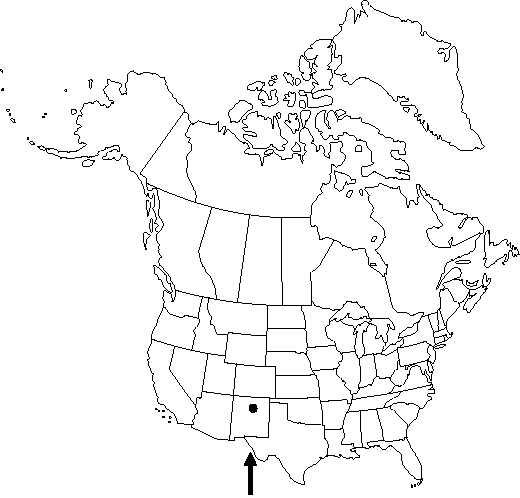Difference between revisions of "Delphinium sapellonis"
Bot. Gaz. 34: 453. 1902.
FNA>Volume Importer |
imported>Volume Importer |
||
| (7 intermediate revisions by 2 users not shown) | |||
| Line 21: | Line 21: | ||
}}<!-- | }}<!-- | ||
| − | --><span class="statement" id="st- | + | --><span class="statement" id="st-undefined" data-properties=""><b>Stems </b>(50-)100-180(-220) cm; base sometimes reddish, glabrous sometimes glaucous. <b>Leaves</b> cauline, 10-20, absent from proximal 1/5 of stem at anthesis; petiole 5-12 cm. <b>Leaf</b> blade round to pentagonal, 6-10 × 8-16 cm, nearly glabrous; ultimate lobes 5-15, width 5-25 mm. <b>Inflorescences</b> (12-)30-80(-120)-flowered; pedicel 0.5-2 cm, glandular-puberulent; bracteoles 3-5 mm from flowers, green to purple, linear, 5-8 mm, glandular-puberulent. <b>Flowers</b>: sepals (in bud) yellowish or brownish purple, becoming browner or yellower with age, glandular-puberulent, lateral sepals forward pointing, 8-12 × 3-5 mm, spurs straight, ascending 20-45° above horizontal, 8-11 mm; lower petal blades slightly elevated, ± exposing stamens, 2.5-5 mm, clefts 1-2 mm; hairs centered, mostly above base of cleft, yellow. <b>Fruits</b> 12-18 mm, 3-4 times longer than wide, puberulent. <b>Seeds</b> wing-margined; seed coat cells elongate, surfaces smooth.</span><!-- |
-->{{Treatment/Body | -->{{Treatment/Body | ||
| Line 28: | Line 28: | ||
|elevation=2600-3500 m | |elevation=2600-3500 m | ||
|distribution=N.Mex. | |distribution=N.Mex. | ||
| − | |discussion=<p>Delphinium sapellonis hybridizes with D. barbeyi and D. robustum. It replaces D. robustum and represents the southern Cordilleran complex at higher elevations of the southern Sangre de Cristo Mountains east of Santa Fe. It is not known elsewhere.</p> | + | |discussion=<p><i>Delphinium sapellonis</i> hybridizes with <i>D. barbeyi</i> and <i>D. robustum</i>. It replaces <i>D. robustum</i> and represents the southern Cordilleran complex at higher elevations of the southern Sangre de Cristo Mountains east of Santa Fe. It is not known elsewhere.</p> |
|tables= | |tables= | ||
|references= | |references= | ||
| Line 37: | Line 37: | ||
-->{{#Taxon: | -->{{#Taxon: | ||
name=Delphinium sapellonis | name=Delphinium sapellonis | ||
| − | |||
|authority=Tidestrom | |authority=Tidestrom | ||
|rank=species | |rank=species | ||
| Line 52: | Line 51: | ||
|publication year=1902 | |publication year=1902 | ||
|special status=Endemic | |special status=Endemic | ||
| − | |source xml=https:// | + | |source xml=https://bitbucket.org/aafc-mbb/fna-data-curation/src/2e0870ddd59836b60bcf96646a41e87ea5a5943a/coarse_grained_fna_xml/V3/V3_753.xml |
|genus=Delphinium | |genus=Delphinium | ||
|section=Delphinium sect. Diedropetala | |section=Delphinium sect. Diedropetala | ||
|subsection=Delphinium subsect. Exaltata | |subsection=Delphinium subsect. Exaltata | ||
|species=Delphinium sapellonis | |species=Delphinium sapellonis | ||
| − | |||
| − | |||
| − | |||
| − | |||
| − | |||
| − | |||
| − | |||
| − | |||
| − | |||
| − | |||
| − | |||
| − | |||
| − | |||
| − | |||
| − | |||
| − | |||
| − | |||
| − | |||
| − | |||
| − | |||
| − | |||
| − | |||
| − | |||
| − | |||
| − | |||
| − | |||
| − | |||
| − | |||
| − | |||
| − | |||
| − | |||
| − | |||
| − | |||
| − | |||
| − | |||
| − | |||
| − | |||
| − | |||
| − | |||
| − | |||
| − | |||
}}<!-- | }}<!-- | ||
-->[[Category:Treatment]][[Category:Delphinium subsect. Exaltata]] | -->[[Category:Treatment]][[Category:Delphinium subsect. Exaltata]] | ||
Latest revision as of 21:51, 5 November 2020
Stems (50-)100-180(-220) cm; base sometimes reddish, glabrous sometimes glaucous. Leaves cauline, 10-20, absent from proximal 1/5 of stem at anthesis; petiole 5-12 cm. Leaf blade round to pentagonal, 6-10 × 8-16 cm, nearly glabrous; ultimate lobes 5-15, width 5-25 mm. Inflorescences (12-)30-80(-120)-flowered; pedicel 0.5-2 cm, glandular-puberulent; bracteoles 3-5 mm from flowers, green to purple, linear, 5-8 mm, glandular-puberulent. Flowers: sepals (in bud) yellowish or brownish purple, becoming browner or yellower with age, glandular-puberulent, lateral sepals forward pointing, 8-12 × 3-5 mm, spurs straight, ascending 20-45° above horizontal, 8-11 mm; lower petal blades slightly elevated, ± exposing stamens, 2.5-5 mm, clefts 1-2 mm; hairs centered, mostly above base of cleft, yellow. Fruits 12-18 mm, 3-4 times longer than wide, puberulent. Seeds wing-margined; seed coat cells elongate, surfaces smooth.
Phenology: Flowering summer.
Habitat: Subalpine meadows and open coniferous forest
Elevation: 2600-3500 m
Discussion
Delphinium sapellonis hybridizes with D. barbeyi and D. robustum. It replaces D. robustum and represents the southern Cordilleran complex at higher elevations of the southern Sangre de Cristo Mountains east of Santa Fe. It is not known elsewhere.
Selected References
None.
